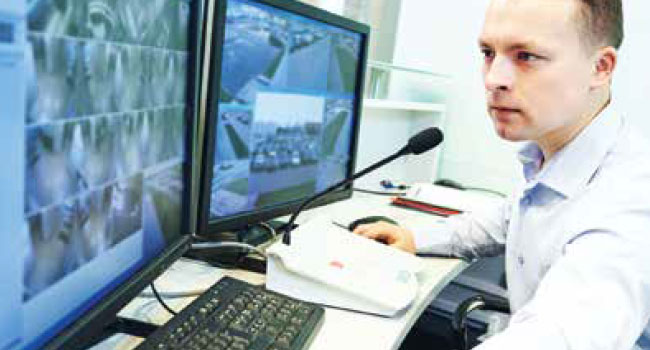
Intelligent Campuses Require An Advanced Security Strategy
The digital revolution has opened the door to a flurry of incoming data from numerous entities
- By Jeffrey Lewis
- October 01, 2019
Although you may immediately
think of educational
facilities when someone
says the word “campus,”
these environments can also
be found across a host of other vertical markets,
including healthcare, government and
business enterprises. Regardless of the specific
market a campus fits into, the management
staff responsible for these facilities are
more focused on security than ever before.
Traditional risks, such as workplace violence,
terrorism and insider threats continue to
evolve, while combating cybersecurity
threats has gained importance when considering
a comprehensive security strategy.
Campus leaders have a tremendous
responsibility in ensuring the protection of
what matters most to their organization—
students and faculty in a university setting,
patients and hospital personnel in a healthcare
setting or corporate employees, customers
and customer data in a business setting.
The stakes are high, and as the impact of
these threats on an organization rises, the
need for a real-time, predictive and comprehensive
security strategy increases.
The Data Challenge for
Campus Environments
The digital revolution and prevalence of connected
devices has opened the door to a
flurry of incoming data from numerous systems
and sensors, and campuses need modern
ways to capture and analyze this information
to make informed decisions. At the
same time, each connected device increases
an organization’s vulnerability to nefarious
activity and data breaches. A new comprehensive
security approach is necessary to
help mitigate these risks so that campus leaders
can gather, process and analyze the data
available to them to enhance security, modernize
services offered on campus and
increase operational efficiency.
The idea of an intelligent campus has
grown over time as we’ve seen the Internet of
Things (IoT) mature. At the same time, artificial
intelligence (AI) and 5G have the
potential to help all types of organizations
offer better services, more robust user experiences
and increased safety. Below, we take a
closer look at which innovations and ideas
are changing the campus security landscape
and how you can gain the most value from
them to improve your campus experience
while protecting what matters most.
The Heart of the Intelligent Campus
In the dynamic and fast-paced campus
environment, security leaders need to look
at managing security threats holistically.
This can be a challenge, however, as security
systems such as intrusion, access control and video surveillance often operate in silos. This makes it difficult
for security leaders to access the information they need when they
need it most.
The Intelligent Security Operations Center (ISOC) is critical to the
success of an intelligent campus and can help address this issue. The
ISOC aggregates multiple systems into a single interface and exposes
it to an analytic layer that results in the delivery of actionable intelligence.
The ISOC incorporates AI to provide data about what is happening
across a campus’ domains and helps operators determine the
impact to the organization. Over time, the ISOC’s ability to unify
incoming data and leverage machine learning to identify patterns and
detect threats will help an organization take a more proactive
approach to their campus security needs.
Automation
At the core of the ISOC is a level of automation that ultimately
increases efficiencies for campus leaders. It’s clear that for campuses
to predict and identify threats in real time, actionable, intelligent data
analysis must take place to present a unified risk scenario to the
appropriate operators.
Advanced analytic applications, in conjunction with enterprise
class security software, address this by gathering, processing and analyzing
the data to deliver greater situational awareness and instant
notifications to facilitate immediate action. These powerful solutions
streamline investigations and empower operators to make rapid,
informed decisions without expensive infrastructure changes.
On the Go
With the introduction of the smartphone, mobility has taken center
stage, even in the security industry. For campuses to stay ahead and
leverage automation and advanced threat detection, information
must be available and accessible anytime, anywhere. The proliferation
of mobile devices makes this possible and gives organizations more
ways to protect people, property and information in mission critical
environments.
For example, there are mobile applications available today that
allow users to press a button on their mobile device and immediately
alert security to a threat. Operators in the central command center
can then open a line of communication with that user, obtain realtime
video of what the user is witnessing, acquire their location and
communicate with that user to update their status.
Additionally, mobile video applications can help security officers
gain more insight to a situation when it occurs. These applications
can push data to their mobile devices in real time from first responders,
employees or citizens providing them with specific information
on a security incident. This helps the operator assess the risk and
respond quicker and more efficiently to the situation at hand. Overall,
mobile capabilities add significant value to any organization’s security
strategy by providing more data to the security operators and extending
their reach far beyond the campus footprint.
The intelligent campus empowers organizations to be more efficient,
effective and proactive in delivering best of breed services while
protecting people, property and information assets in today’s everevolving
risk environment. Security in an intelligent campus scenario
is extremely complex. Security operators must balance the high
expectations for an elevated and modernized campus experience,
with the need to protect what matters most. This type of environment
requires a comprehensive, coherent and cohesive security plan.
This article originally appeared in the September/October 2019 issue of Campus Security Today.